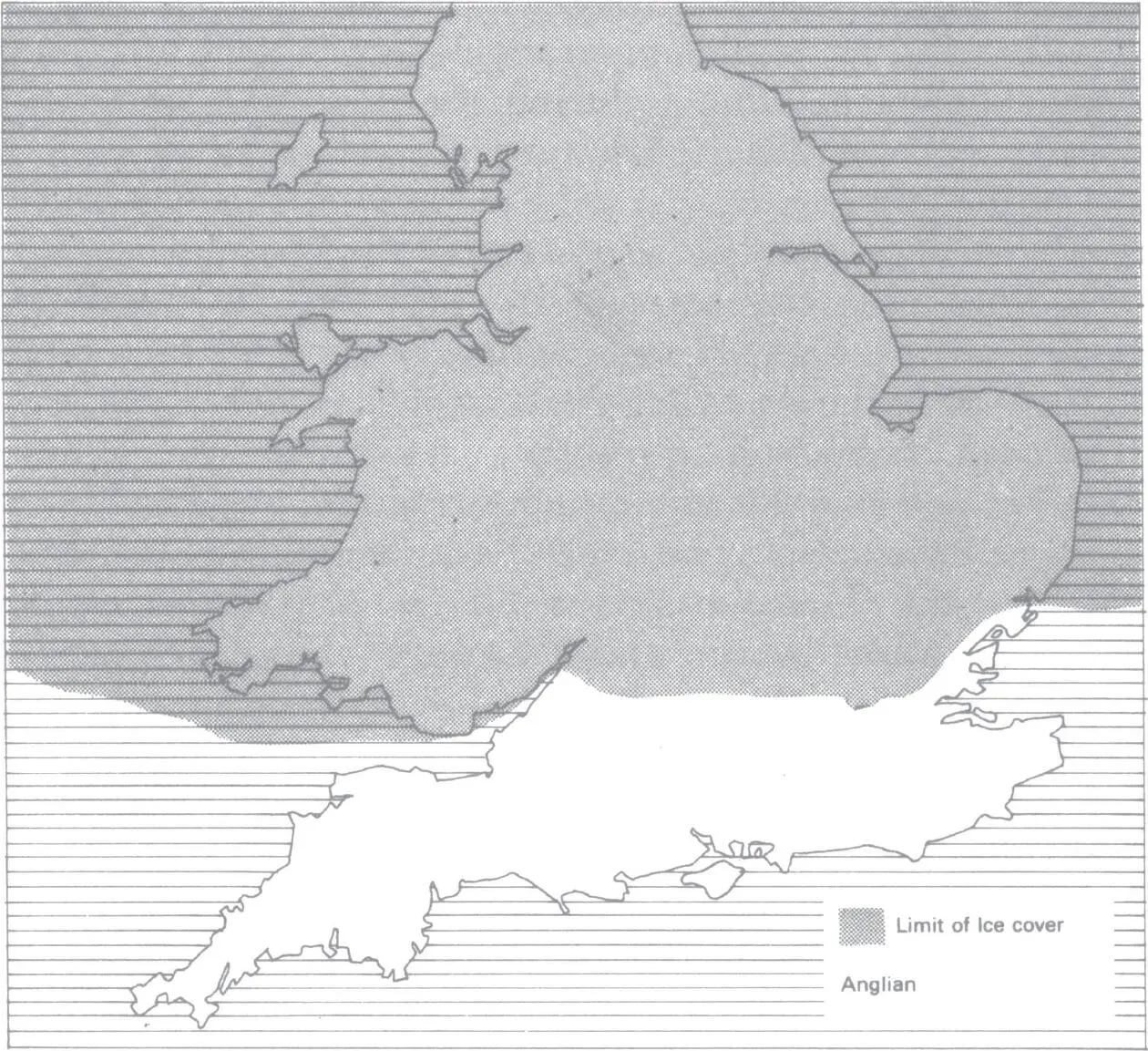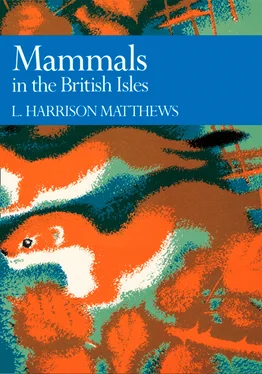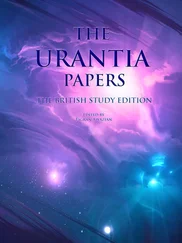The last glaciation, the Würm, reached its peak about 20,000 years ago, but it was not so severe or long-lasting as some preceeding ones. During the Mindel glaciation the ice sheets reached their greatest size and covered an enormous area of Europe, much more extensive than that covered in the later Riss and Würm stages. The interglacial stage between the decline of the Mindel and the onset of the Riss lasted nearly a quarter of a million years, during which a contemporary intelligence might have thought that ice ages had gone never to return. Although the Günz was designated the oldest or first glaciation, there are now known to be indications of numerous glaciations older still, hence the differences of opinion between authorities on the probable length of the Pleistocene epoch. There cannot, in any case, have been any sharply defined boundary between the Pliocene and the Pleistocene, for the whole of geological and biological evolution is a continuous process. The boundaries between all the geological epochs are arbitrary, and are used merely as a convenience with the tacit admission that they cannot represent any specific moment in time.
The history of the Pleistocene is, however, by no means the simple and clear cut sequence as might appear from the basic pattern. During glaciations the edges of the ice sheets advance and retreat to different extents and in different places, and during interglacial periods they re-advance from place to place and retire again in an unending chain of fluctuations that bring variations in topography, climate, flora and fauna. Furthermore, the sequence worked out for the glaciations of the Alps may not correspond exactly with those found elsewhere.
Geologists of many lands studying the glaciations and alternating interglacial periods of the Pleistocene in their own countries have gone deeply into the problems of correlating their local findings with the basic alpine pattern. A general measure of success has been achieved in this though much detail remains obscure, and the sequences in Scandinavia and northern Europe and in North America are found to correspond reasonably closely. They are, as well, found to correspond with the pluvial sequences found in land further south which, though never covered with ice sheets, experienced periods of high rainfall when the ice held more northern latitudes in its grip.
Although the pattern of successive glaciations in the Alps corresponds roughly with that of other parts of Europe and elsewhere, it is in some ways a special case. Even at the maximum of glaciation when a continuous sheet of ice blanketed northern Europe and Asia and covered the British Isles and the site of the North Sea, the ice cap over the Alps was separate and not continuous with the great ice sheet. The causes of the glaciations were similar for both regions but the effects were subject to local variations; consequently the nomenclature for the Alpine glaciations is now applied less uniformly to those of regions further north, including the British Isles.
The difficulty of making exact correlations between Pleistocene events in different places has been resolved by classifying them according to local stratigraphy. Pleistocene deposits, both those of glacial and interglacial stages, are not continuous, and the geologists have to put together the history of the epoch from the examination of scattered and limited samples from many different places. The glacial and interglacial stages are named after the places where well-known deposits of each stage have been studied, and consequently the nomenclature for north western Europe differs from that for the Alps, and from that for the British Isles. Thus the last or Würm glaciation of the Alps corresponds to the Weichselian glaciation of north-western Europe, and the Devensian of the British Isles.
In the British Isles many of the typical pleistocene sites are found in East Anglia and take their names from nearby towns and villages of Norfolk, Suffolk and Essex. The last glaciation however takes its name from the Devenses, the ancient British tribe that lived over 50,000 years later in the area including Four Ashes in Staffordshire, the typical site. 128The succession of deposits is not complete, so that information is lacking about the earliest Pleistocene, and for a period of about a million years in the middle Pleistocene. In spite of these gaps the deposits indicate alternating colder and warmer phases but give no unequivocal evidence of glaciation, with ice sheets covering much of the country, until comparatively late in the epoch when ice cover reached its maximum during the Anglian glaciation, corresponding with the Elster glaciation of northwest Europe and the Mindel of the Alps.
Conditions immediately after the end of the Pliocene, some two to two-and-a-half million years ago, are imperfectly known but there appears to have been a cold stage at first, represented by the Nodule Bed at the base of the Red Crag deposits of East Anglia. A gap in the record of nearly half a million years is then followed by an alternation of two warm and two cold stages represented by pre-glacial deposits of the lower Pleistocene. These are the Ludhamian (Ludham, near Norwich) warm, Thurnian (river Thurn, Norfolk), cold, Antian (river Ant, Norfolk) warm, and Baventian (Easton Bavents, near Southwold, Suffolk) cold. At the end of the Baventian stage another gap in the record lasting about a million years is followed by the warm Pastonian stage (Paston, near Cromer, Norfolk), the first stage of the middle Pleistocene, about half a million years ago.
The following Beestonian (Beeston, near Dereham, Norfolk) was the first cold stage of the middle Pleistocene and was succeeded by a warm stage, the Cromerian (Cromer, Norfolk), which lasted until the onset of the great glaciation over 450,000 years ago. This, the Anglian glacial stage (East Anglia), lasted between fifty and sixty thousand years and covered the whole of the British Isles as far south as the Thames with a sheet of ice that produced the greatest glaciation in the whole of the Pleistocene. When the Anglian stage came to an end the land was free of ice for about 185,000 years during the temperate Hoxnian stage (Hoxne, on the Suffolk–Norfolk border near Eye and Diss); in this stage the temperature was at times higher than that of the present day.
The next glaciation, the Wolstonian (Wolston, near Coventry, Warwickshire) lasted some 60,000 years from about 240,000 to 180,000 B.P. The ice cover did not extend as far south as in the Anglian stage; the ice edge ran south from northern Norfolk and then west across the midlands to the mid Welsh border, thence turning south to reach and follow the north coasts of Somerset, Devon and Cornwall. The succeeding Ipswichian (Ipswich, Suffolk) temperate stage lasted about 60,000 years until about 120,000 B.P. when the cold returned with the onset of the last, Devensian, glacial stage in which the ice covered Scotland, northern England, Wales, and most of Ireland. A large area of the midlands and east Yorkshire was thus free from ice cover, though the ice covering the North Sea encroached on the east coast as far south as Norfolk. The ice of the Devensian stage melted comparatively quickly some twelve thousand years ago so that before 10,000 B.P. the post glacial or Flandrian temperate stage was established, which extends to the present day; it takes its name from the transgression of the North Sea over the former dry land bordered by England and Flanders, when the sea level rose as the water from the ice returned to the sea.

Fig. 3. Limit of ice covering during (a) the Anglian, (b) the Wolstonian and (c) the Devensian glaciations.
Читать дальше













